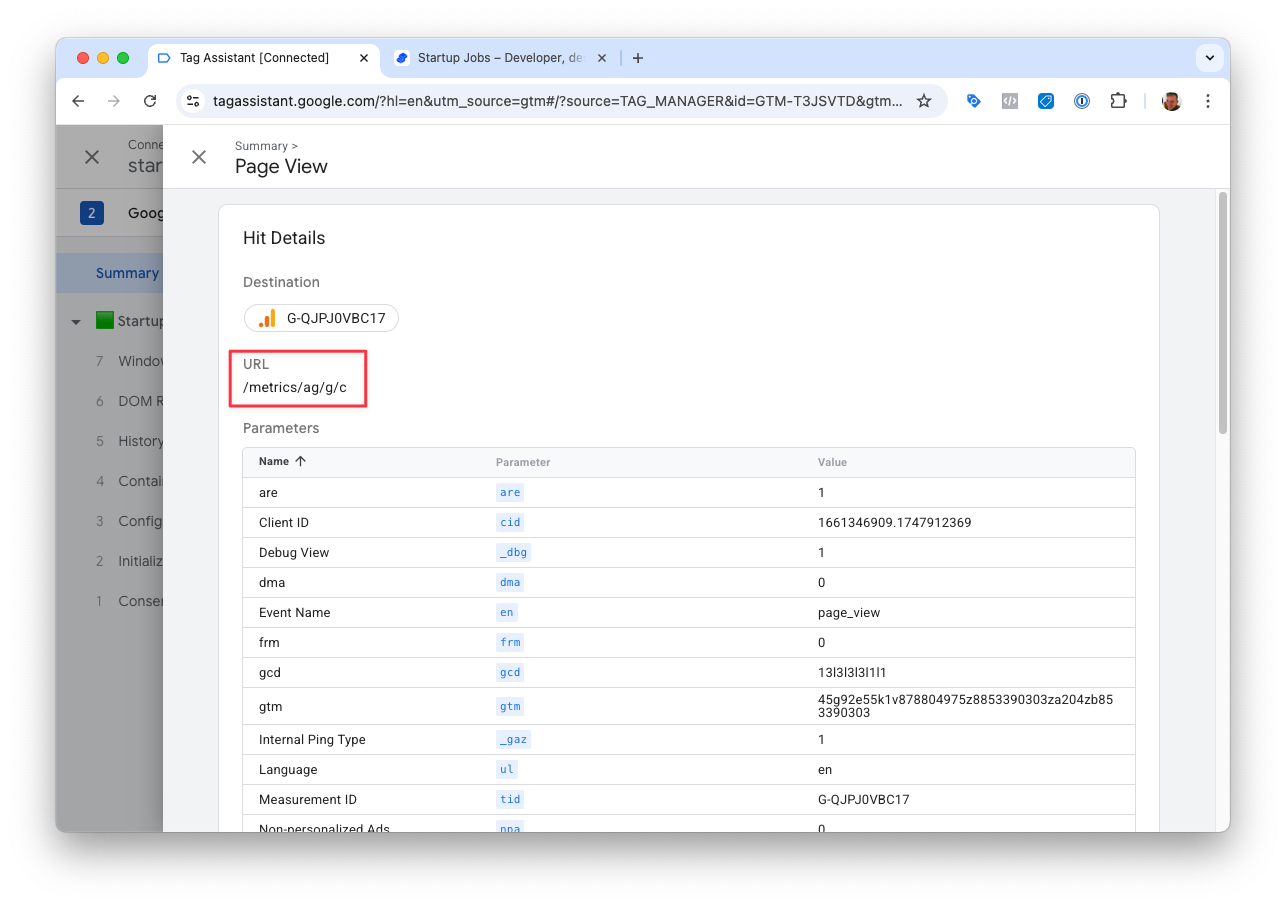Enhanced Conversions
This is a feature only available for users of the Pro version. Get the Pro version here.
The diagnostics report in Google is delayed. If it shows one or several warnings, please wait a few days, sometimes up to two weeks, and recheck before contacting our support.
Enhanced Conversions is a feature that can improve the accuracy of your conversion measurement. It supplements your existing conversion tags by sending hashed first-party conversion data from your shop in a privacy-safe way.
Setup
Setup instructions:
-
Enable Google Enhanced Conversions in the Pixel Manager.
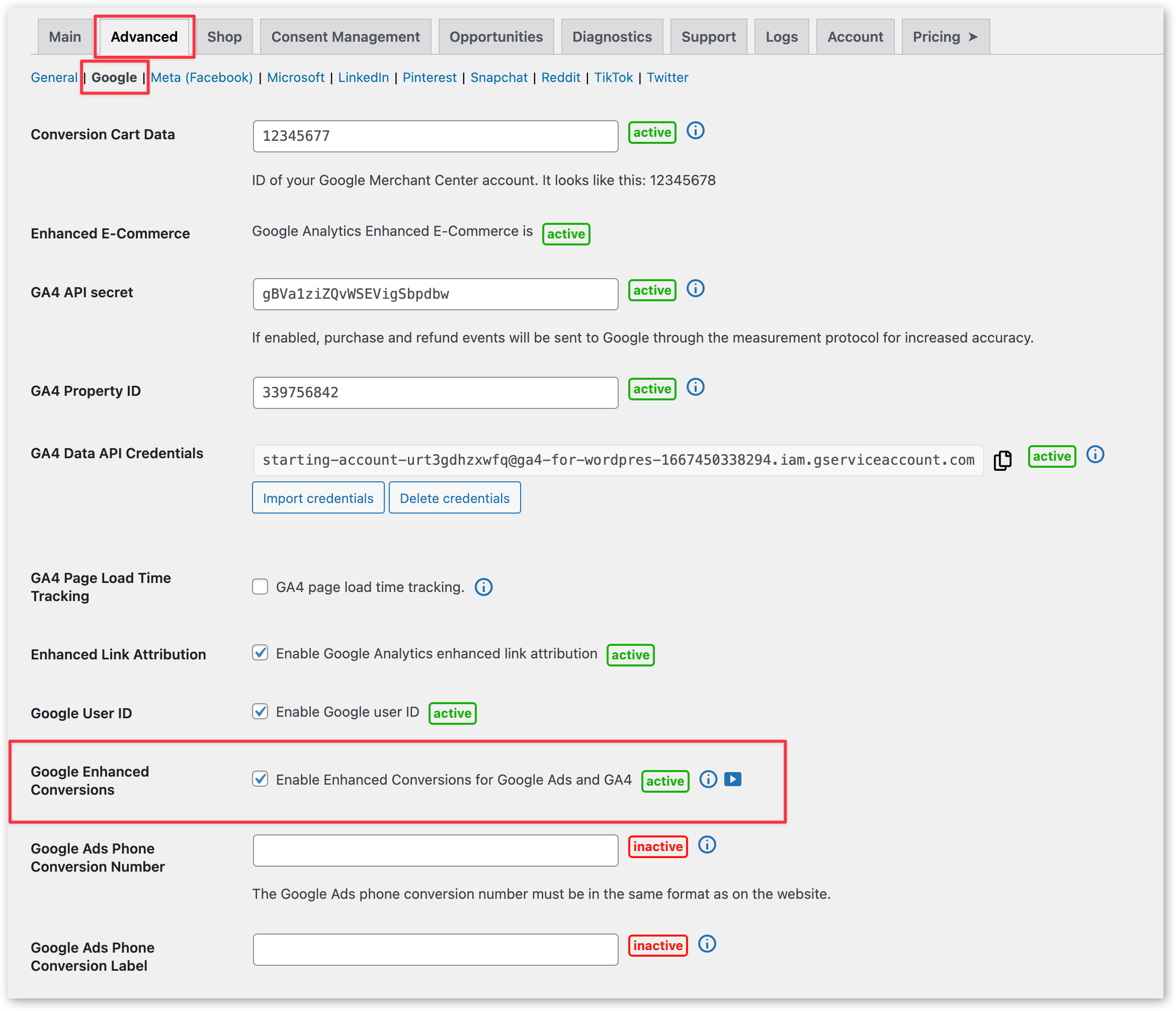
-
Activate Enhanced Conversions in your Google account.
This can be done either in Google Ads and/or GA4.
A. Activation in GA4: https://support.google.com/analytics/answer/14078702
B. Activation in Google Ads: https://support.google.com/google-ads/answer/9888656
Validate your implementation
To verify if your enhanced conversions implementation is working correctly, navigate to your conversion page (you may have to complete a test order to do this), and follow these steps.
- Right click on your web page.
- Select Inspect.
- Select the Network tab.
- Enter your conversion ID or conversion label into the search bar.
- Find the network request that's going to "googleadservices.com/pagead/conversion/" (or "google.com/pagead/1p-conversion/" on some browsers).
- In the Headers part of the Network request, scroll to “Query String Parameters”. Here, you should find that there is a parameter “em” with a hashed string as the value. If you see the "em" parameter, this means that the enhanced conversions tag is correctly picking up and hashing the enhanced_conversion_data object.

Google tag gateway for advertisers
This feature is available for all users of the free and the Pro version from version 1.48.0 and up.
Google tag gateway for advertisers lets you deploy a Google tag using your own first-party infrastructure, hosted on your website's domain. By serving tags from your own domain, you can significantly improve the accuracy and resilience of your measurement signals. According to Google, advertisers who configured Google tag gateway for advertisers saw an 11% uplift in signals. Read more about the Google tag gateway for advertisers here.
Setup preparation
Setting up the Google tag gateway for advertisers is a two-step process.
First, you need to enable the Google tag gateway for advertisers in the Pixel Manager. This is very easy.
Then, you need to set up the Google tag gateway for advertisers on your website infrastructure, such as a content delivery network (CDN), load balancer, or web server.
If you are using Cloudflare as a CDN, the setup is very easy. As of now, Cloudflare is the only CDN that offers a simple setup with just a few clicks. (Others will probably follow soon, but as of now, Cloudflare is the only one.)
In our setup guide we will show you how to set up the Google tag gateway for advertisers on Cloudflare.
No matter which CDN, load balancer or web server you use, the Pixel Manager configuration always remains the same. The only thing that changes is the setup on your CDN, load balancer or web server.
If you are not using Cloudflare but another CDN, load balancer, or web server, this will require advanced technical knowledge. If you are not familiar with this, we recommend that you reach out to your website developer or hosting provider for assistance. You can find the setup instructions in the Google documentation here.
The Google tag gateway for advertisers doesn't route all traffic through you domain. It will still use the Google domain for some traffic. Most events will be routed through your domain. (This is documented by Google here. Screenshot).
Full setup using Cloudflare (manual and recommended)
Cloudflare must be set up in proxy mode (orange cloud enabled). If you are using Cloudflare in DNS-only mode (grey cloud), the Google tag gateway for advertisers will not work through Cloudflare's native integration.
- Go to Pixel Manager settings > Advanced > Google > Google Tag Gateway Measurement Path
- Choose a path that is not already in use on your site. For example,
/metrics. - Copy the path.
- Go to your Cloudflare account: https://dash.cloudflare.com/
- If you have multiple accounts, select the account that you want to use.
- Don't select a specific domain yet. Just select the account. On the left side, you will see a menu. Click on Tag Management > Google Tag Gateway.
- Then click on the domain you want to set up the Google tag gateway for advertisers for.
- Click the Configure button.
- Paste the path you copied from the Pixel Manager into the Measurement Path field.
- Go back to the Pixel Manager and copy the Google tag ID.
- Go back to Cloudflare and paste the Google tag ID into the Google tag ID field.
- Keep the rest of the settings as they are. Don't enable
Set up tag - Click the Save button.
Done! The Google tag gateway for advertisers is now set up and active on your website.
Full setup using Cloudflare (semi-automatic)
Cloudflare must be set up in proxy mode (orange cloud enabled). If you are using Cloudflare in DNS-only mode (grey cloud), the Google tag gateway for advertisers will not work through Cloudflare's native integration.
- Go to your Google Ads account: https://ads.google.com/
- Open > Tools > Data Manager
- Click on > Google tag > Manage
- In the menu click > Admin > Google tag gateway
- Click Continue.
- Click Sign into Cloudflare and follow the instructions to connect your Cloudflare account.
- Click Choose domains and select the domain you want to set up the Google tag gateway for advertisers for. Then click Done.
- Click Complete setup.
Google Ads has set up the Cloudflare integration for you with the Google Ads tag and a random custom path. You need to either copy the path over to the Pixel Manager or set a new path in Cloudflare and copy that over to the Pixel Manager. It is important that the path in the Pixel Manager and in Cloudflare are exactly the same.
- Open the Google tag gateway settings in Cloudflare: https://dash.cloudflare.com/
- If you have multiple accounts, select the account that you want to use.
- Don't select a specific domain yet. Just select the account. On the left side, you will see a menu. Click on Tag Management > Google Tag Gateway.
- Then click on the domain you want to set up the Google tag gateway for advertisers for.
- Click the Update Configuration button.
- Copy the existing path or set a new path that is not already in use on your site. For example,
/metrics. - Disable
Set up tag. - Click the Save button.
- Go back to the Pixel Manager > Settings > Advanced > Google and paste the path into the Google Tag Gateway Measurement Path field.
- Save the settings in the Pixel Manager.
That's it! The Google tag gateway for advertisers is now set up and active on your website.
Google tag ID
The Pixel Manager will provide you with a Google tag ID. This is the ID that you need to use in your CDN, load balancer, or web server. You can find the Google tag ID in the Pixel Manager settings for Google.
Pixel Manager Settings > Advanced > Google > Google tag ID
The Google tag ID may look different depending which Google products you have activated in the Pixel Manager.
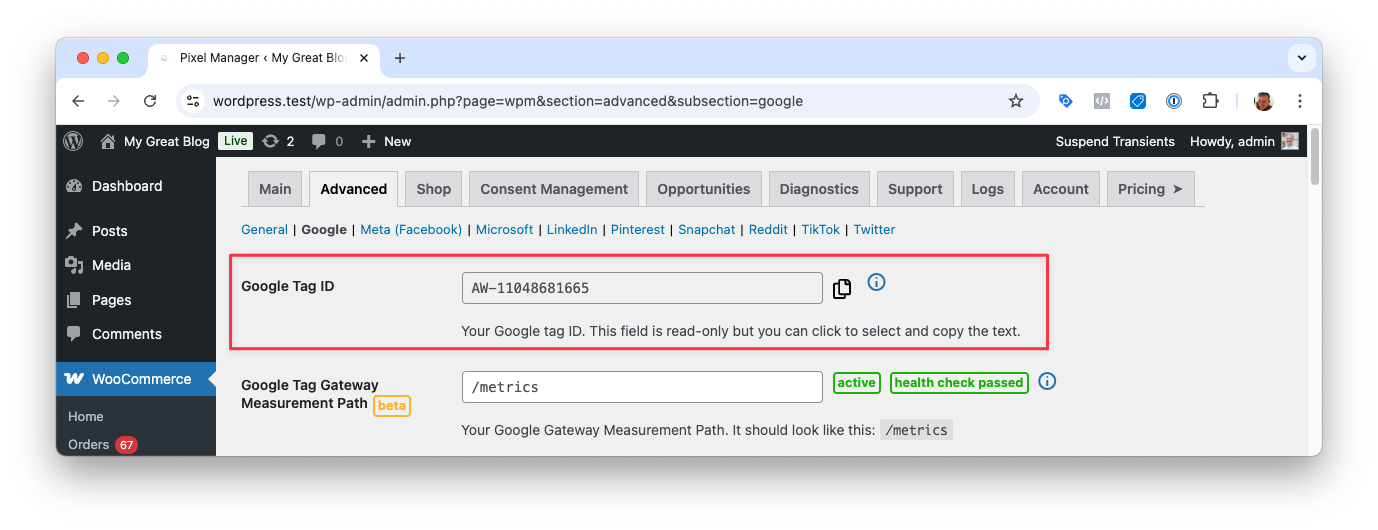
If you need to override the Google tag ID in the Pixel Manager, you can do this using the following filter: Google tag ID filter.
If you ever chose to change the Google settings and disable/enable Google Ads or GA4, check if the Google tag ID is still correct. If not, you need to upated it in the CDN, load balancer, or web server.
Measurement path
You must reserve a path on your website domain for serving the tag. This path needs to be set in the Pixel Manager and in your CDN, load balancer, or web server.
Pixel Manager Settings > Advanced > Google > Google Tag Gateway Measurement Path
To set up Google tag gateway for advertisers, choose any path that isn't already in use on your site. To reduce the likelihood of conflicting with a path already on the site, you can choose any combination of letters and numbers, or if you want a more readable path, you can choose to use a word such as /metrics, /securemetric, /analytics, or any other word you want.
Requirements for the path:
- The path must not already be in use on your site.
- The path must not be the root path
/. - It may not exceed 100 characters.
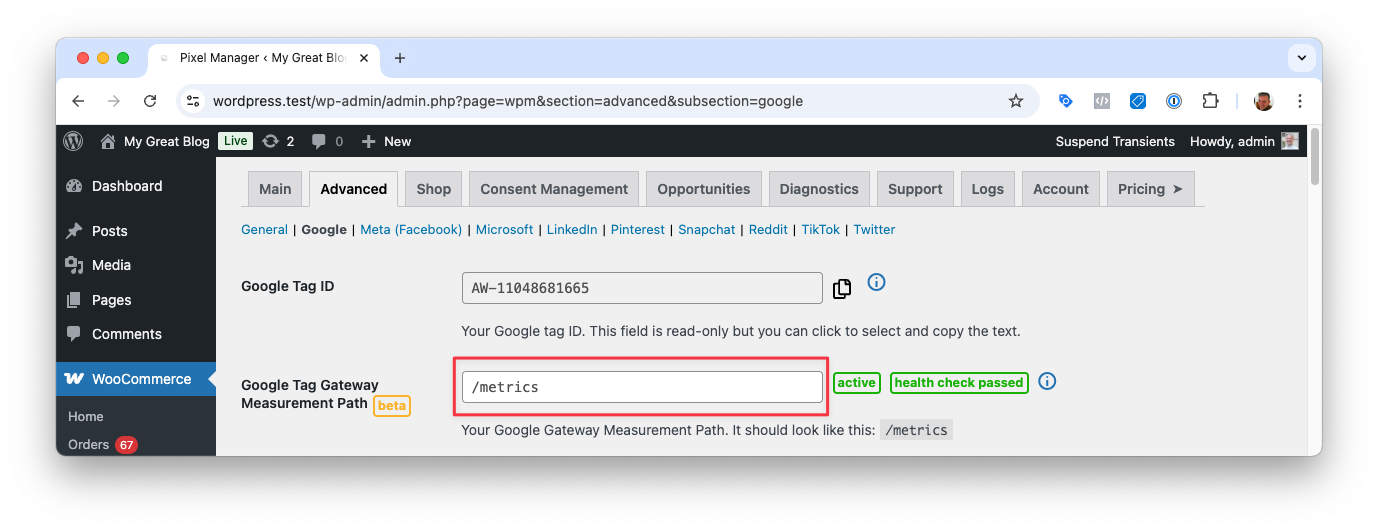
Health Check
The health check in the settings will show if the CDN, load balancer, or web server is set up correctly. If the health check fails, it means that the Google tag gateway for advertisers is not set up correctly in the CDN, load balancer, or web server.
Don't worry. The Pixel Manager will automatically fall back to the regular Google tag if the health check fails. This means that your Google tags will keep working, but you won't benefit from the Google tag gateway for advertisers until the setup is fixed.
Once the setup is fixed, simply refresh the page in the Pixel Manager and the health check will be re-run.
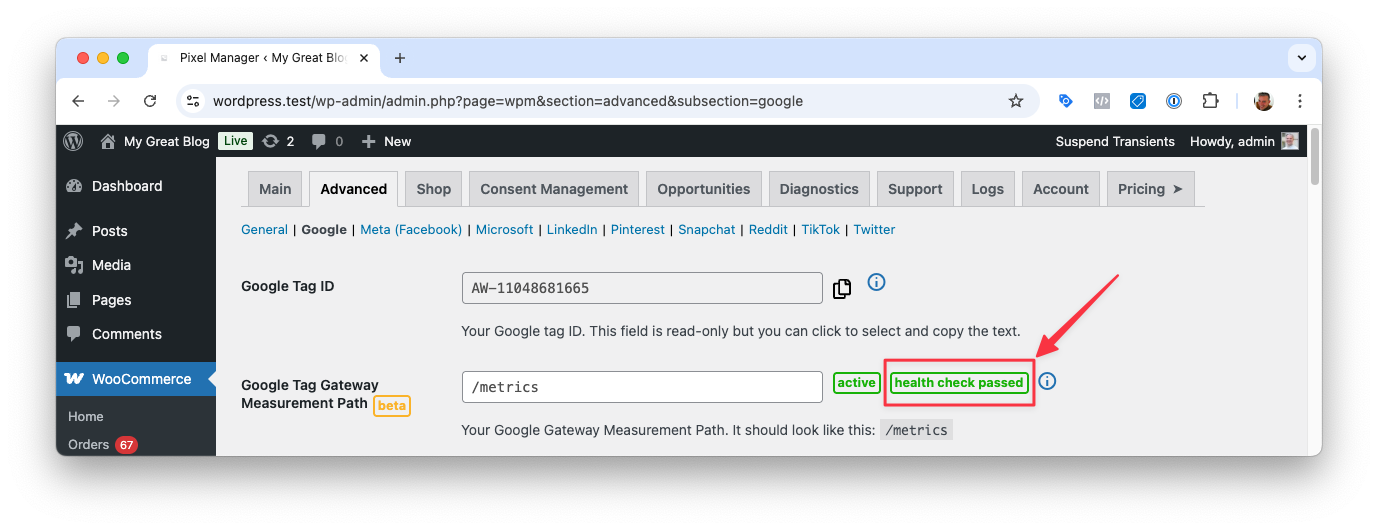
If the Pixel Manager can't connect to the Google tag gateway for advertisers, it will automatically fall back to the regular Google tag.
The health check only works if outgoing requests are allowed. If something is blocking outgoing requests, such as custom configuration, a plugin or your hosting provider, the health check will show as failed. If everything is set up correctly, the Google tag gateway for advertisers will still work. You can do the health check manually by going to following path in your browser: https://yourdomain.com/your-measurement-path/healthy. If the page shows the text ok, the Google tag gateway for advertisers is set up correctly on your CDN, load balancer, or web server. If you see a 404 Not Found response, the Google tag gateway for advertisers is not set up correctly on your CDN, load balancer, or web server.
Verify
The are several ways to verify if the Google tag gateway for advertisers is working correctly.
Check network requests
Open the developer tools in your browser and check the network requests. Set a filter for the path you set in the Pixel Manager. For example, if you set the path to /metrics, set a filter for /metrics. Then reload the page and check if any requests are going to the path you set in the Pixel Manager.
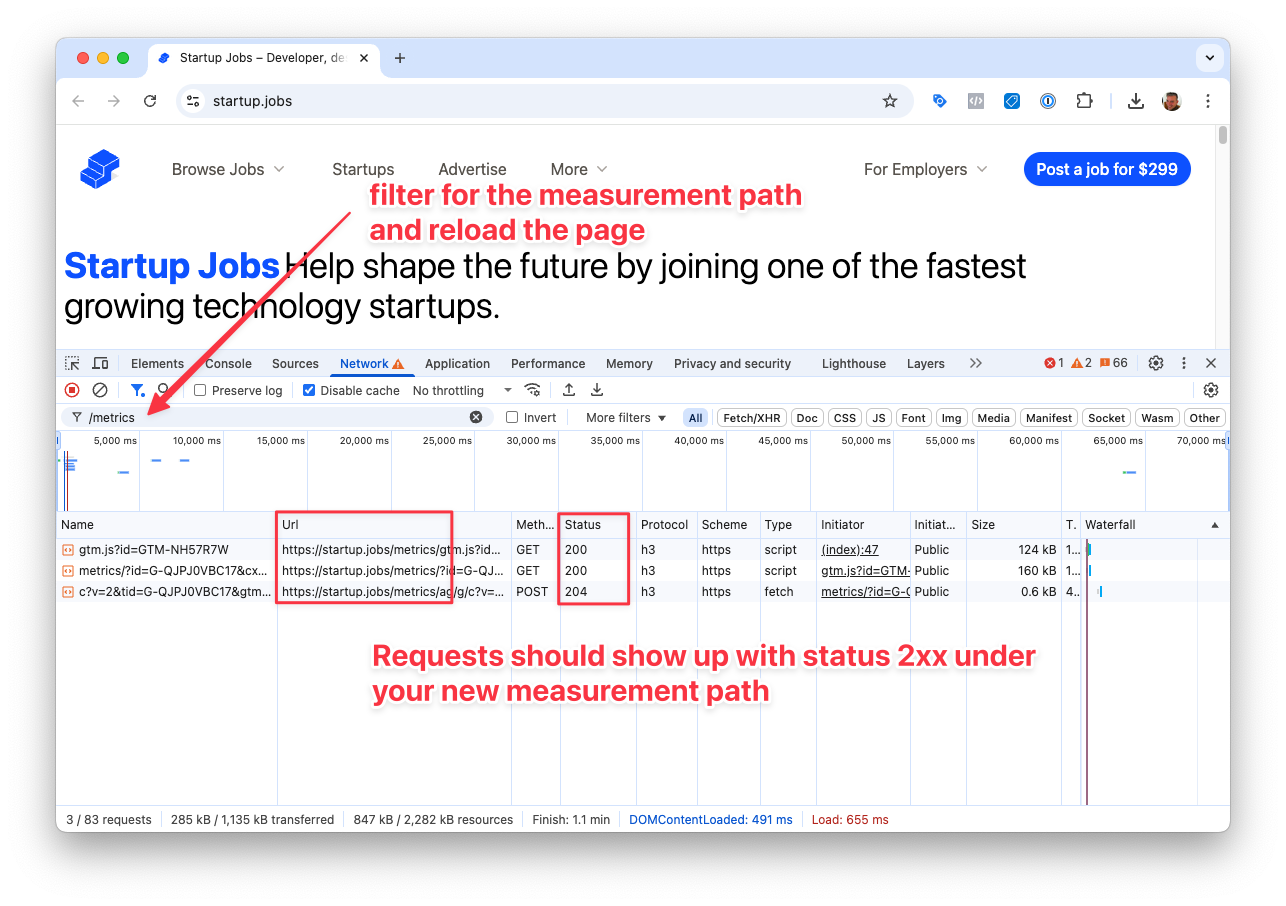
Use the Pixel Manager Console Debugger
Open your website and append ?pmwloggeron to the URL like so https://yourdomain.com/?pmwloggeron. This will enable the Pixel Manager Console Debugger.
Then open the developer tools in your browser and check the console. You should see two messages.
The first one shows from which path the Google tag is loaded like this: Pixel Manager: Loading Google gtag.js from https://yourdomain.com/metrics.
The second message shows if the script was loaded successfully like this: Pixel Manager: Successfully loaded primary script: /metrics/.
If you see both messages, the Google tag gateway for advertisers is working correctly.
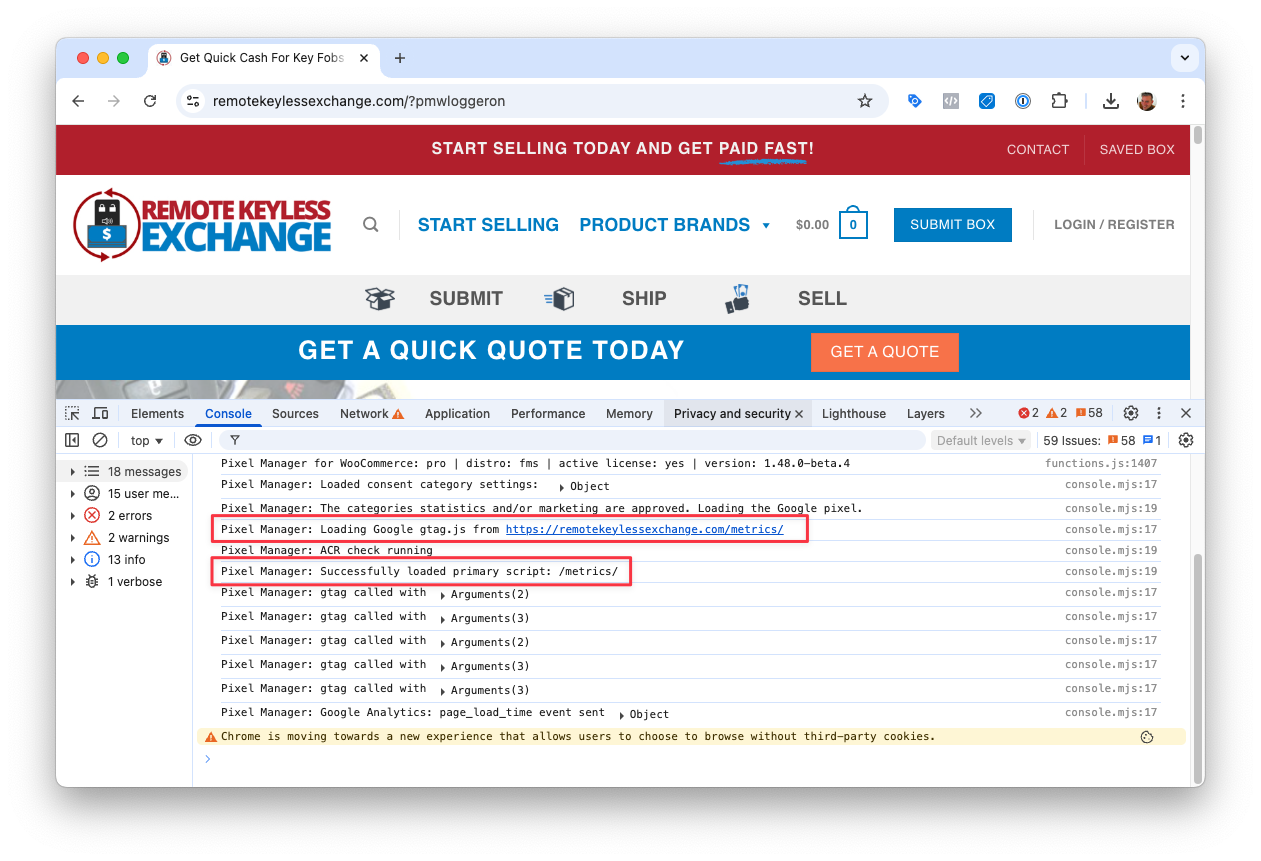
Google Tag Assistant
You can also use the Google Tag Assistant to verify if the Google tag gateway for advertisers is working correctly.
Open the Google Tag Assistant https://tagassistant.google.com/ and click on the Add domain button. Enter your domain and click Connect. Your domain will automatically be loaded in a separate tab.
Find a PageView event in the list and click on it.
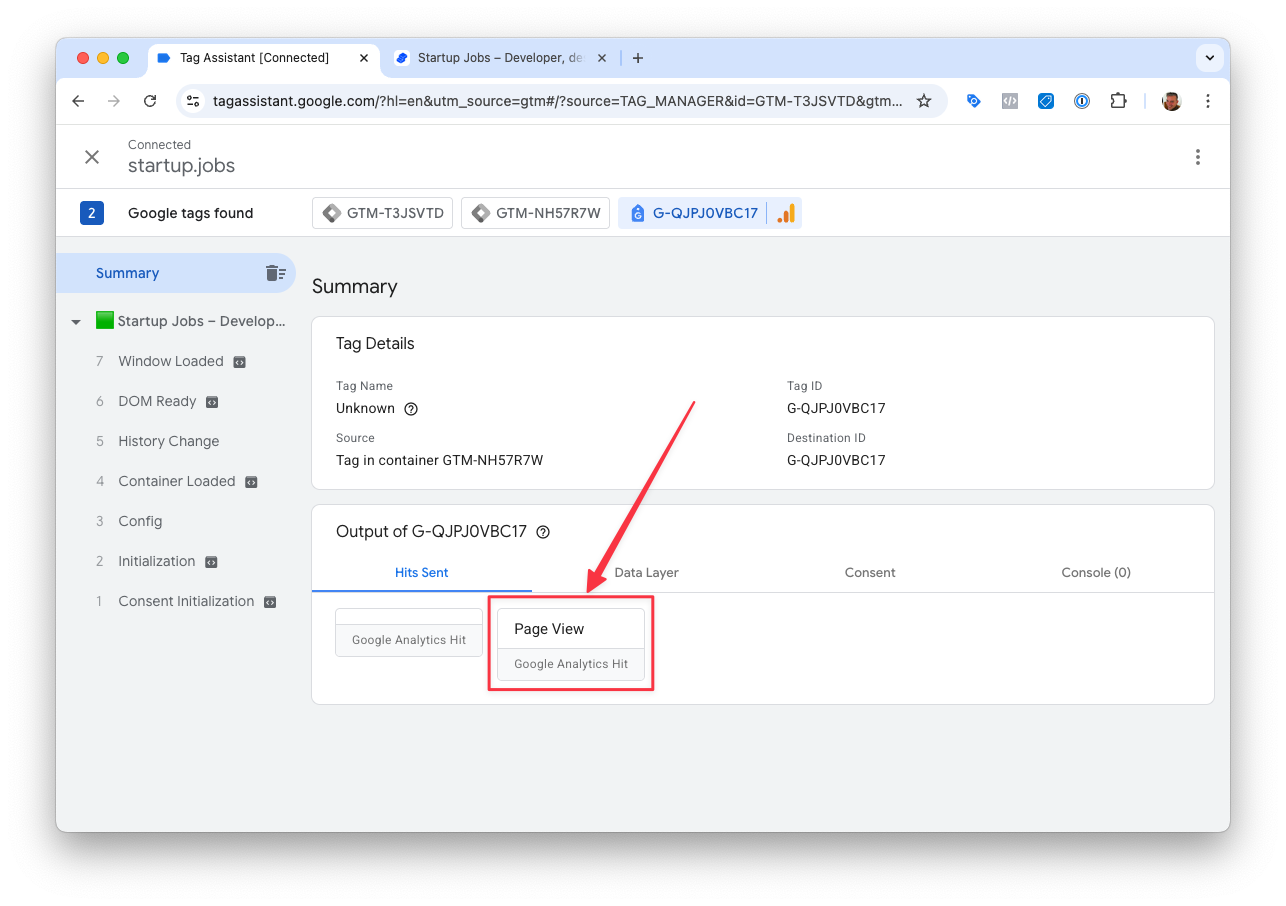
It will show that it was loaded through your measurement path. (e.g. /metrics/).
